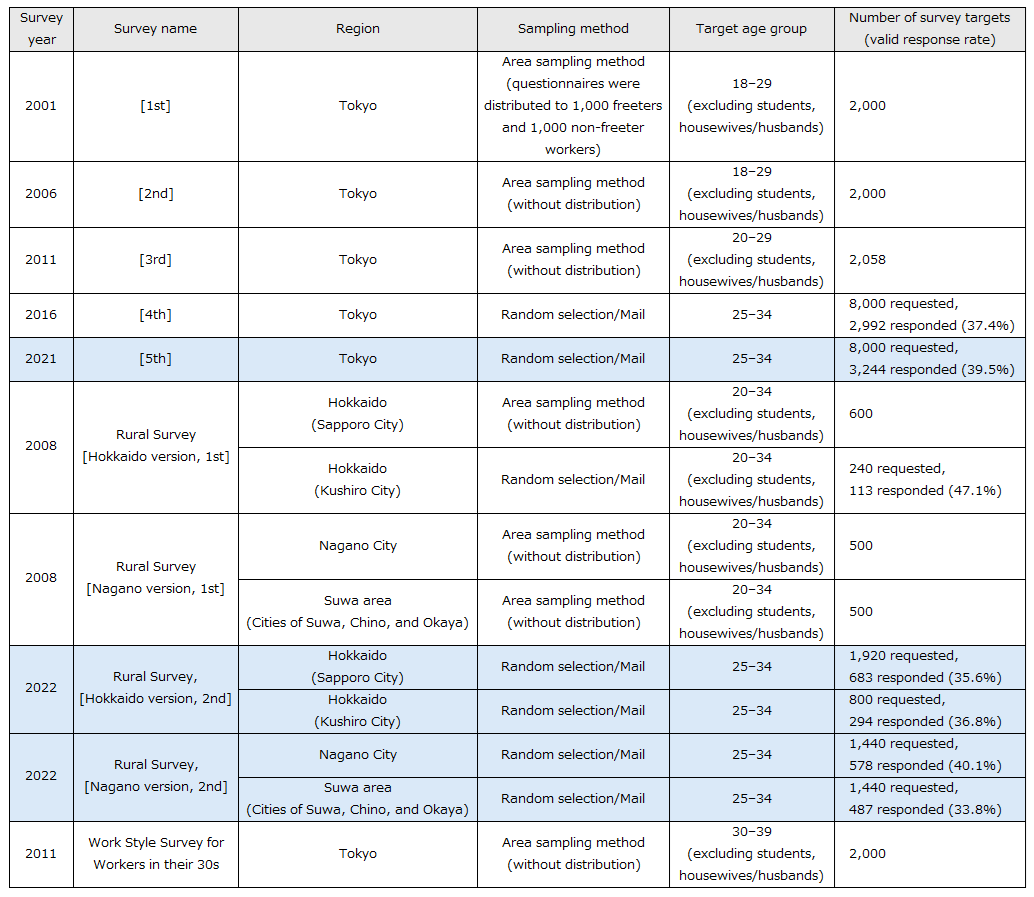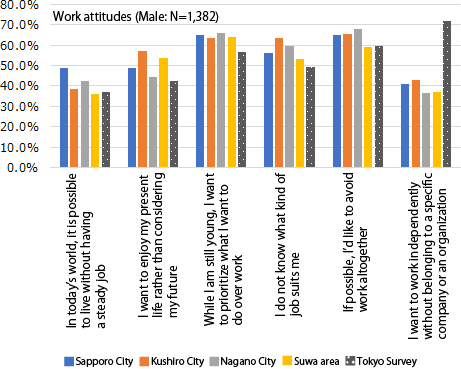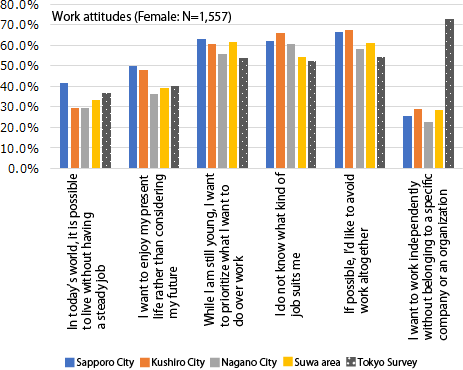JILPT Research Report No.231
Career Change and Work Attitudes Among Young People in Rural Areas: A Comparison of the Hokkaido and Nagano with Tokyo Based on JILPT’s “Survey on the Working Style of Young People”
July 4, 2024
Summary
Research Objective
To clarify the career consciousness and work attitudes among young people living in rural areas by comparing them with those living in a major city (Tokyo), based on existing research findings. Since 2001, the "Survey on the Working Style of Young People" has been conducted in Tokyo every five years. For comparative purposes, a survey of workers in their 30s was also conducted in the past. The rural version of the survey has been conducted since 2008. This report analyzes these results, including the latest rural survey conducted in 2022, about 15 years after the previous one. This report mainly analyzes the results of those shaded in the table below.
Overview of “Survey on the Working Style of Young People”

Research Method
The rural surveys were sent by mail to individuals aged 25 to 34 who were randomly selected from the Basic Resident Register. Responses were accepted both by post and on the web.
Survey requests were sent to 1,920 individuals in Sapporo City, of whom 683 responded (valid response rate: 35.6%). In Kushiro City, 800 individuals were contacted, and 294 responded (36.8%). In Nagano City, 1,440 individuals were contacted, and 578 responded (40.1%). In the Suwa area (including the cities of Suwa, Chino, and Okaya), 1,440 individuals were contacted, and 487 responded (33.8%).
Key Findings
For the purpose of selecting rural survey areas, we classified the regions into three types based on the job market conditions and industrial structure. Type 1 is Tokyo, characterized by a high number of job openings and a strong inflow of labor. Type 2 is Nagano, an area mainly based on the manufacturing industry, which also has a number of job openings. Type 3 is Hokkaido, an area characterized by the service industry, with a limited number of job openings. We selected Nagano City and the Suwa area (including cities of Suwa, Chino, and Okaya) for the survey of Nagano version, and Sapporo City and Kushiro City for the survey of Hokkaido version, as the areas with unique characteristics. The following section focuses on changes in career disparities and work attitudes (including increased disinterest in work and decreased "steadiness") associated with rising levels of higher educational attainment, as observed in the 2021 Tokyo Survey.
Looking at the changes in the percentage of regular employees hired immediately after graduating from school, the 2008 Rural Surveys showed that disparities in the educational attainment, as seen in the Tokyo Survey, were small in both survey areas. Among women, the rate of regular employment was actually lower among graduates from universities and graduate schools. However, in the 2022 Rural Surveys, the rate of regular employment among high school graduates immediately after leaving school was higher than in Tokyo. The disparities based on educational attainment were not as large as in Tokyo, but among men, such disparities began to appear, and they became more evident among women. This may be due to an increase in the number of higher education graduates who majored in medical, nursing, welfare, or education-related fields and are settling in the region and working as regular employees.
Figure 1. Percentage of regular employees immediately after leaving school (Aged 25 to 34)

Note: Figures for the 2006 Tokyo Survey include only individuals in their late 20s. Note that the surveys in Sapporo City and Kushiro City, and in Suwa area and Nagano City were conducted in 2022, and the Tokyo Survey was conducted in 2021.
Next, from the 2021 Tokyo Survey, it is observed that “disinterest in work” is growing— particularly among young people who would like to avoid work altogether if possible—and that “steadiness” has weakened. As the past rural surveys did not include this item, the current analysis focuses only on regional differences. The trend of disinterest in work was more pronounced among young people in rural areas than in Tokyo—though there were no significant differences among men—and steadiness was also weaker in rural areas. The proportion of young people who answered “I do not know what kind of job suits me” was higher in rural areas. The proportion of young people who prefer freelance work (not belonging to a specific company or organization and working independently) is significantly higher in Tokyo. This could be considered a typical tendency among young people in larger cities.
Figure 2. Differences in Work Attitudes Among Regions (Ages 25–34)
Male

Female

Note: The surveys in Sapporo City and Kushiro City, and Suwa area and Nagano city, were conducted in 2022, and Tokyo Survey was conducted in 2021.
***p<.001,**p<.01,p*<.05,†p<.10
Regarding the use of public support, the use of Hello Work (Public Employment Security Offices) was significantly higher in rural cities than in Tokyo. Although the figure is omitted, it is observed that the utilization rate of public support, such as Hello Work, is high when young people attempt to transition from freeter status to regular employment, suggesting that such support plays an important role in rural areas.
Figure 3. The situation of usage of public support

Note: The survey in Sapporo City and Kushiro City, and Suwa area and Nagano City, were conducted in 2022, and the Tokyo Survey was conducted in 2021.
Policy Implications
- Compared to the past surveys from 2001 to 2016, the influence of educational attainment on one’s career has increased although there are differences due to the industrial structure of the area. It is necessary to continue tracking the influence of the industrial structure on the work style of young people in the future.
- There has been an increase in “disinterest in work” and a decrease in “steadiness” in both urban and rural areas. It is essential to reconsider the relationship between workplaces and young people—one which neither overly binds them nor places full responsibility solely on them.
- Hello Work and other forms of public support have consistently played an important role in rural areas. It is necessary to continue supporting young people, especially in these areas.
Contents
JILPT Research Report No.231, full text (PDF:28.5MB) [in Japanese]
Category
Human resources management/vocational skills development, Employment/unemployment
Research Period
FY 2022–2024
Researchers
- HORI Yukie
- Research Director, Career Development, The Japan Institute for Labour Policy and Training (JILPT), Research interest: Sociology of Education.
- OGURO Megumi
- Researcher, Career Development, JILPT
- KOSUGI Reiko
- Former Research Director, JILPT
- RYU Hwangseok
- Lecturer (Part-time), Nihon University
- UEYAMA Kojiro
- Lecturer, Hokkaido University, School of Education
- NAKAJIMA Yuri
- Associate Professor, Nagasaki University
For Citation
JILPT. 2024. Chiho no wakamono no kyaria no henka to shokugyo ishiki: Hokkaido/Nagano chosa oyobi Tokyo-to chosa tono hikaku kara [Career Change and Work Attitudes Among Young People in Rural Areas: A Comparison of the Hokkaido and Nagano with Tokyo Based on JILPT’s “Survey on the Working Style of Young People”]. JILPT Research Report no.231. Tokyo: The Japan Institute for Labour Policy and Training.
Related Research
- JILPT Research Report No.213, Changes in Work and Consciousness of Youth in Major Urban Areas: From the 5th “Survey on the Working Style of Young People” (2022)
- JILPT Research Report No.108, Employment Behavior and School-to-Work Transition of Provincial Youth (2009) (PDF:96KB)
JILPT Research Report at a Glance
| To view PDF files, you will need Adobe Acrobat Reader Software installed on your computer.The Adobe Acrobat Reader can be downloaded from this banner. |

